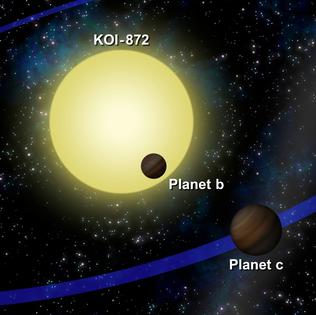Related Research Articles

A proplyd, short for ionized protoplanetary disk, is an externally illuminated photoevaporating protoplanetary disk around a young star. Nearly 180 proplyds have been discovered in the Orion Nebula. Images of proplyds in other star-forming regions are rare, while Orion is the only region with a large known sample due to its relative proximity to Earth.
Photoevaporation denotes the process where energetic radiation ionises gas and causes it to disperse away from the ionising source. This typically refers to an astrophysical context where ultraviolet radiation from hot stars acts on clouds of material such as molecular clouds, protoplanetary disks, or planetary atmospheres.

An exomoon or extrasolar moon is a natural satellite that orbits an exoplanet or other non-stellar extrasolar body.

A debris disk, or debris disc, is a circumstellar disk of dust and debris in orbit around a star. Sometimes these disks contain prominent rings, as seen in the image of Fomalhaut on the right. Debris disks are found around stars with mature planetary systems, including at least one debris disk in orbit around an evolved neutron star. Debris disks can also be produced and maintained as the remnants of collisions between planetesimals, otherwise known as asteroids and comets.

Kepler-46, previously designated KOI-872, is a star located in the constellation Lyra. Observed since 2009 by the Kepler space observatory, it has since been found to possess a planetary system consisting of at least three planets and while it has a similar mass to the Sun (90%) it is significantly older at ten billion years.
Kepler-80, also known as KOI-500, is a red dwarf star of the spectral type M0V. This stellar classification places Kepler-80 among the very common, cool, class M stars that are still within their main evolutionary stage, known as the main sequence. Kepler-80, like other red dwarf stars, is smaller than the Sun, and it has both radius, mass, temperatures, and luminosity lower than that of our own star. Kepler-80 is found approximately 1,223 light years from the Solar System, in the stellar constellation Cygnus, also known as the Swan.
Kepler-68d is a gas giant with the minimum mass about the same as Jupiter. It is at least a jovian-mass planet orbiting 1.4 astronomical units from its parent star, Kepler-68, well within habitable zone of the star. It was detected by radial velocity.
Kepler-32 is an M-type main sequence star located about 1070 light years from Earth, in the constellation of Cygnus. Discovered in January 2012 by the Kepler spacecraft, it shows a 0.58 ± 0.05 solar mass (M☉), a 0.53 ± 0.04 solar radius (R☉), and temperature of 3900.0 K, making it half the mass and radius of the Sun, two-thirds its temperature and 5% its luminosity.

Kepler-56 is a red giant in constellation Cygnus roughly 3,060 light-years (940 pc) away with slightly more mass than the Sun.

Kepler-90, also designated 2MASS J18574403+4918185, is an F-type star located about 2,790 light-years (855 pc) from Earth in the constellation of Draco. It is notable for possessing a planetary system that has the same number of observed planets as the Solar System.

Kepler-25 is a star in the northern constellation of Lyra. It is slightly larger and more massive than the sun with a luminosity 21⁄2 times that of the sun. With an apparent visual magnitude of 10.6, this star is too faint to be seen with the naked eye.

David Robert Ciardi is an American astronomer. He received a bachelor's degree in physics and astronomy from Boston University in 1991, and a Ph.D. in physics from the University of Wyoming in 1997.
Kepler-296 is a binary star system in the constellation Draco. The primary star appears to be a late K-type main-sequence star, while the secondary is a red dwarf.
Kepler-421 is a yellow main sequence star, being of spectral class G7V. Orange star of spectral class K9V, projected on sky plane just 1.085″ away, is not physically associated to it. The distance to star KOI-1274 A is approximately 1150 light-years, and to KOI-1274 B is about 1900 light-years.

Tabetha "Tabby" Suzanne Boyajian is an American astronomer of Armenian descent and astrophysicist on faculty at Louisiana State University. She was a post-doctoral fellow 2012–16 at Yale University, working with Debra Fischer. Boyajian is active in the astronomical fields of stellar interferometry, stellar spectroscopy, exoplanet research, and high angular resolution astronomy, all particularly at optical and infrared wavelengths. She was the lead author of the September 2015 paper "Where's the Flux?", which investigated the highly unusual light curve of KIC 8462852; the star is colloquially known as Tabby's Star in her honor.
Kepler-26e is an exoplanet orbiting the star Kepler-26, located in the constellation Lyra. It was discovered by the Kepler telescope in February 2014. It orbits its parent star at only 0.220 astronomical units and completes an orbit once every 46.8 days. It is potentially habitable.
HD 168009 is a star in the northern constellation of Lyra. It has an apparent visual magnitude of 6.3, placing it just above to below the normal limit of stars visible to the naked eye under good viewing conditions of 6-6.5. An annual parallax shift of 42.93 mas provides a distance estimate of 76 light years. It is moving closer to the Sun with a heliocentric radial velocity of −65 km/s. In about 328,000 years from now, the star will make its closest approach at a distance of around 17 ly (5.1 pc).
The small planet radius gap is an observed scarcity of planets with radii between 1.5 and 2 times Earth's radius, likely due to photoevaporation-driven mass loss. A bimodality in the Kepler exoplanet population was first observed in 2013, and was noted as possibly confirming an emerging hypothesis that photoevaporation could drive atmospheric mass loss on close-in, low-mass planets. This would lead to a population of bare, rocky cores with smaller radii at small separations from their parent stars, and planets with thick hydrogen- and helium-dominated envelopes with larger radii at larger separations. The bimodality in the distribution was confirmed with higher-precision data in the California-Kepler Survey in 2017, which was shown to match the predictions of the photoevaporative mass-loss hypothesis later that year.
Kepler-63 is a G-type main-sequence star about 638 light-years away. The star is much younger than the Sun, at 0.21 billion years. Kepler-63 is similar to the Sun in its concentration of heavy elements.
References
- 1 2 "Fowler Award (A): Dr James Owen" (PDF). Retrieved 29 October 2021.
- 1 2 "James Owen's Personal Webpage" . Retrieved 29 October 2021.
- 1 2 "James Owen CV" (PDF). Retrieved 29 October 2021.
- ↑ "STSc Hubble Fellows" . Retrieved 29 October 2021.
- ↑ "Royal Society announces University Research Fellowships for 2016" . Retrieved 29 October 2021.
- ↑ "James Owen PIP Imperial College" . Retrieved 29 October 2021.
- ↑ Owen, James E.; Wu, Yanqin (2013-09-12). "Keplerplanets: A Tale of Evaporation". The Astrophysical Journal. IOP Publishing. 775 (2): 105. arXiv: 1303.3899 . doi:10.1088/0004-637x/775/2/105. ISSN 0004-637X. S2CID 119267058.
- 1 2 "Imperial News". 3 September 2019. Retrieved 29 October 2021.
- 1 2 3 4 Google Scholar Author page, Accessed Dec. 7, 2021